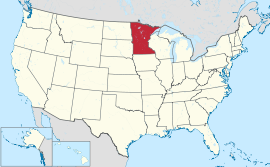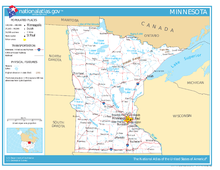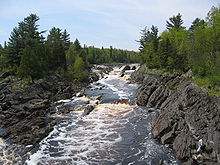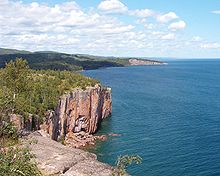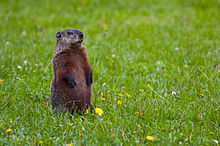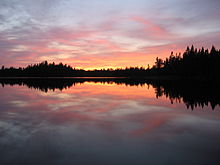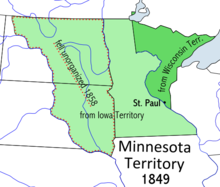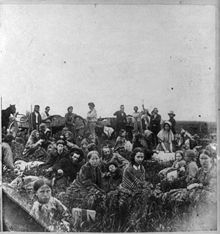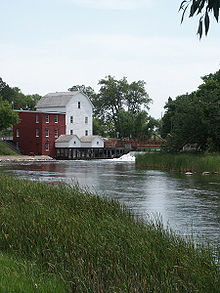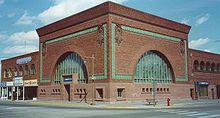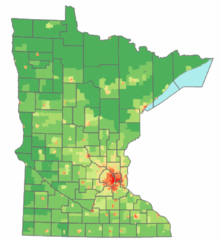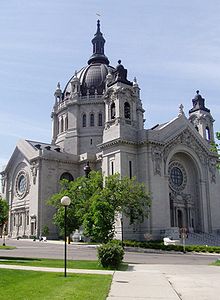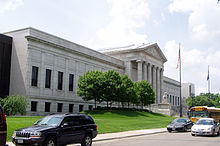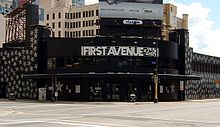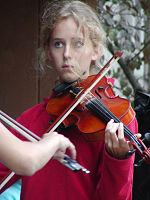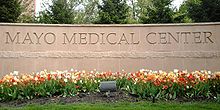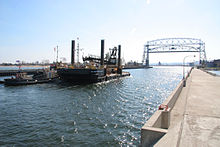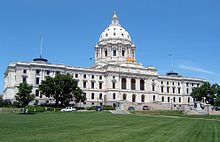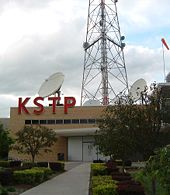- Minnesota
-
This article is about the U.S. state of Minnesota. For the river, see Minnesota River. For other uses, see Minnesota (disambiguation).
State of Minnesota 

Flag Seal Nickname(s): North Star State;
Land of 10,000 Lakes; The Gopher StateMotto(s): L’Étoile du Nord (French: The Star of the North) Demonym Minnesotan Capital Saint Paul Largest city Minneapolis Largest metro area Minneapolis-Saint Paul Area Ranked 12th in the U.S. - Total 86,939 sq mi
(225,181 km2)- Width c. 200–350 miles (c. 320–560 km) - Length c. 400 miles (c. 640 km) - % water 8.4 - Latitude 43° 30′ N to 49° 23′ N - Longitude 89° 29′ W to 97° 14′ W Population Ranked 21st in the U.S. - Total 5,303,925 (2010) [1]
4,919,479 (2000)- Density 65.3/sq mi (25.21/km2)
Ranked 31st in the U.S.- Median income $55,802 (10th[2]) Elevation - Highest point Eagle Mountain[3][4]
2,302 ft (701 m)- Mean 1,200 ft (370 m) - Lowest point Lake Superior[3][4]
601 ft (183 m)Before statehood Minnesota Territory Admission to Union May 11, 1858 (32nd) Governor Mark Dayton (DFL) Lieutenant Governor Yvonne Prettner Solon (DFL) Legislature Minnesota Legislature - Upper house Senate - Lower house House of Representatives U.S. Senators Amy Klobuchar (DFL)
Al Franken (DFL)U.S. House delegation 4 Democrats, 4 Republicans (list) Time zone Central: UTC-6/-5 Abbreviations MN Minn. US-MN Website www.state.mn.us Minnesota
 i/mɪnɨˈsoʊtə/[5] is a U.S. state located in the Midwestern United States. The twelfth largest state of the U.S., it is the twenty-first most populous, with 5.3 million residents. Minnesota was carved out of the eastern half of the Minnesota Territory and admitted to the Union as the thirty-second state on May 11, 1858. Known as the Land of 10,000 Lakes, the state's name comes from a Dakota word for "sky-tinted water". Those waters, together with forests, parks, and wilderness areas, offer residents and tourists a variety of outdoor recreational opportunities.
i/mɪnɨˈsoʊtə/[5] is a U.S. state located in the Midwestern United States. The twelfth largest state of the U.S., it is the twenty-first most populous, with 5.3 million residents. Minnesota was carved out of the eastern half of the Minnesota Territory and admitted to the Union as the thirty-second state on May 11, 1858. Known as the Land of 10,000 Lakes, the state's name comes from a Dakota word for "sky-tinted water". Those waters, together with forests, parks, and wilderness areas, offer residents and tourists a variety of outdoor recreational opportunities.Nearly 60% of Minnesota's residents live in the Minneapolis-Saint Paul metropolitan area known as the "Twin Cities", the center of transportation, business, industry and education, and home to an internationally known arts community. The remainder of the state consists of western prairies now given over to intensive agriculture; deciduous forests in the southeast, now cleared, farmed and settled; and the less populated North Woods, used for mining, forestry, and recreation.
Minnesota is known for its relatively mixed social and political orientations, and has a high rate of civic participation and voter turnout. Minnesota ranks among the healthiest states, and has a highly literate population. The large majority of residents are of Scandinavian and German descent. The state is known as a center of Scandinavian American culture. Ethnic diversity has increased in recent decades. Substantial influxes of African, Asian, and Latin American immigrants have joined the descendants of European immigrants and the original Native American inhabitants.
Contents
Etymology
The word Minnesota comes from the Dakota name for the Minnesota River: Mnisota. The root mni (also spelled mini or minne) means, "water". Mnisota can be translated as sky-tinted water or somewhat clouded water.[5][6] Native Americans demonstrated the name to early settlers by dropping milk into water and calling it mnisota.[6] Many locations in the state have similar names, such as Minnehaha Falls ("waterfall"), Minneiska ("white water"), Minneota ("much water"), Minnetonka ("big water"), Minnetrista ("crooked water"), and Minneapolis, which is a combination of mni and polis, the Greek word for "city".[7]
Geography
Minnesota is the northernmost U.S. state apart from Alaska; its isolated Northwest Angle in Lake of the Woods is the only part of the 48 contiguous states lying north of the 49th Parallel. The state is part of the U.S. region known as the Upper Midwest. The state shares a Lake Superior water border with Michigan and Wisconsin on the northeast; the remainder of the eastern border is with Wisconsin. Iowa is to the south, North Dakota and South Dakota to the west, and the Canadian provinces of Ontario and Manitoba to the north. With 86,943 square miles (225,180 km2),[8] or approximately 2.25% of the United States,[9] Minnesota is the twelfth-largest state.[10]
Geology and terrain
Minnesota contains some of the oldest rocks found on earth, gneisses some 3.6 billion years old, or 80% as old as the planet.[3][11] About 2.7 billion years ago, basaltic lava poured out of cracks in the floor of the primordial ocean; the remains of this volcanic rock formed the Canadian Shield in northeast Minnesota.[11][12] The roots of these volcanic mountains and the action of Precambrian seas formed the Iron Range of northern Minnesota. Following a period of volcanism 1.1 billion years ago, Minnesota's geological activity has been more subdued, with no volcanism or mountain formation, but with repeated incursions of the sea, which left behind multiple strata of sedimentary rock.[11]
In more recent times, massive ice sheets at least one kilometer thick ravaged the landscape of the state and sculpted its current terrain.[11] The Wisconsin glaciation left 12,000 years ago.[11] These glaciers covered all of Minnesota except the far southeast, an area characterized by steep hills and streams that cut into the bedrock. This area is known as the Driftless Zone for its absence of glacial drift.[13] Much of the remainder of the state outside of the northeast has 50 feet (15 m) or more of glacial till left behind as the last glaciers retreated. Gigantic Lake Agassiz formed in the northwest 13,000 years ago. Its bed created the fertile Red River valley, and its outflow, glacial River Warren, carved the valley of the Minnesota River.[11] Minnesota is geologically quiet today; it experiences earthquakes infrequently, and most of them are minor.[14]
The state's high point is Eagle Mountain at 2,301 feet (701 m), which is only 13 miles (21 km) away from the low of 602 feet (183 m) at the shore of Lake Superior.[12][15] Notwithstanding dramatic local differences in elevation, much of the state is a gently rolling peneplain.[11]
Two major drainage divides meet in the northeastern part of Minnesota in rural Hibbing, forming a triple watershed. Precipitation can follow the Mississippi River south to the Gulf of Mexico, the Saint Lawrence Seaway east to the Atlantic Ocean, or the Hudson Bay watershed to the Arctic Ocean.[16]
The state's nickname, The Land of 10,000 Lakes, is no exaggeration; there are 11,842 Minnesota lakes over 10 acres (0.040 km2) in size.[17] The Minnesota portion of Lake Superior is the largest at 962,700 acres (3,896 km2) and deepest (at 1,290 ft (390 m)) body of water in the state.[17] Minnesota has 6,564 natural rivers and streams that cumulatively flow for 69,000 miles (111,000 km).[17] The Mississippi River begins its journey from its headwaters at Lake Itasca and crosses the Iowa border 680 miles (1,090 km) downstream.[17] It is joined by the Minnesota River at Fort Snelling, by the St. Croix River near Hastings, by the Chippewa River at Wabasha, and by many smaller streams. The Red River, in the bed of glacial Lake Agassiz, drains the northwest part of the state northward toward Canada's Hudson Bay. Approximately 10.6 million acres (42,900 km²) of wetlands are contained within Minnesota's borders, the most of any state except Alaska.[18]
Flora and fauna
Minnesota has four ecological provinces: Prairie Parkland in the southwestern and western parts of the state, the Eastern Broadleaf Forest (Big Woods) in the southeast, extending in a narrowing strip to the northwestern part of the state, where it transitions into Tallgrass Aspen Parkland, and the northern Laurentian Mixed Forest, a transitional forest between the northern boreal forest and broadleaf forests to the south.[19] These northern forests are a vast wilderness of pine and spruce trees mixed with patchy stands of birch and poplar.
Much of Minnesota's northern forest underwent logging at some time, leaving only a few patches of old growth forest today in areas such as in the Chippewa National Forest and the Superior National Forest where the Boundary Waters Canoe Area Wilderness has some 400,000 acres (161,874 ha) of unlogged land.[20] Although logging continues, regrowth keeps about one third of the state forested.[21] Nearly all of Minnesota's prairies and oak savannas have been destroyed or fragmented because of farming, grazing, logging, and suburban development.[22]
While loss of habitat has affected native animals such as the pine marten, elk, woodland caribou, and bison,[23] others like whitetail deer and bobcat thrive. The state has the nation's largest population of timber wolves outside Alaska,[24] and supports healthy populations of black bear and moose. Located on the Mississippi Flyway, Minnesota hosts migratory waterfowl such as geese and ducks, and game birds such as grouse, pheasants, and turkeys. It is home to birds of prey including the bald eagle, red-tailed hawk, and snowy owl. The lakes teem with sport fish such as walleye, bass, muskellunge, and northern pike, and streams in the southeast are populated by brook, brown, and rainbow trout.
Climate
Minnesota endures temperature extremes characteristic of its continental climate; with cold winters and hot summers. The record high and low span is 174 degrees Fahrenheit (from −60 °F (−51 °C) at Tower on February 2, 1996 to 114 °F (46 °C) at Moorhead on July 6, 1936) Fahrenheit (span of 96C°; from -51 °C to 45 °C).[25] Meteorological events include rain, snow, blizzards, thunderstorms, hail, derechos, tornadoes, and high-velocity straight-line winds. The growing season varies from 90 days per year in the Iron Range to 160 days in southeast Minnesota near the Mississippi River, and mean average temperatures range from 37 °F (2 °C) to 49 °F (9 °C).[26] Average summer dew points range from about 58 °F (14.4 °C) in the south to about 48 °F (8.9 °C) in the north.[26][27] Depending on location, average annual precipitation ranges from 19 in (48.3 cm) to 35 in (88.9 cm), and droughts occur every 10 to 50 years.[26]
Protected lands
Minnesota's first state park, Itasca State Park, was established in 1891, and is the source of the Mississippi River.[28] Today Minnesota has 72 state parks and recreation areas, 58 state forests covering about four million acres (16,000 km²), and numerous state wildlife preserves, all managed by the Minnesota Department of Natural Resources. There are 5.5 million acres (22,000 km²) in the Chippewa and Superior National Forests. The Superior National Forest in the northeast contains the Boundary Waters Canoe Area Wilderness, which encompasses over a million acres (4,000 km²) and a thousand lakes. To its west is Voyageurs National Park. The Mississippi National River and Recreation Area (MNRRA), is a 72 miles (116 km) long corridor along the Mississippi River through the Minneapolis-St. Paul Metropolitan Area connecting a variety of sites of historic, cultural, and geologic interest.[29]
History
Before European settlement, Minnesota was populated by the Anishinaabe, the Dakota, and other Native Americans. The first Europeans were French fur traders that arrived in the 17th century. Late that century, Ojibwe Indians migrated westward to Minnesota, causing tensions with the Sioux.[30] Explorers such as Daniel Greysolon, Sieur du Lhut, Father Louis Hennepin, Jonathan Carver, Henry Schoolcraft, and Joseph Nicollet, among others, mapped out the state.
The portion of the state east of the Mississippi River became a part of the United States at the end of the American Revolutionary War, when the Second Treaty of Paris was signed. Land west of the Mississippi River was acquired with the Louisiana Purchase, although a portion of the Red River Valley was disputed until the Treaty of 1818.[31] In 1805, Zebulon Pike bargained with Native Americans to acquire land at the confluence of the Minnesota and Mississippi rivers. The construction of Fort Snelling followed between 1819 and 1825.[32] Its soldiers built a grist mill and a sawmill at Saint Anthony Falls, the first of the water-powered industries around which the city of Minneapolis later grew. Meanwhile, squatters, government officials, and tourists had settled near the fort. In 1839, the Army forced them to move downriver, and they settled in the area that became St. Paul.[33] Minnesota Territory was formed on March 3, 1849. Thousands of people had come to build farms and cut timber, and Minnesota became the 32nd U.S. state on May 11, 1858.
Treaties between European settlers and the Dakota and Ojibwe gradually forced the natives off their lands and on to smaller reservations. As conditions deteriorated for the Dakota, tensions rose, leading to the Dakota War of 1862.[34] The result of the six-week war was the execution of 38 Dakota — the largest mass execution in United States history — and the exile of most of the rest of the Dakota to the Crow Creek Reservation in Nebraska.[31] As many as 800 white settlers died during the war.[35]
Logging and farming were mainstays of Minnesota's early economy. The sawmills at Saint Anthony Falls, and logging centers like Marine on St. Croix, Stillwater, and Winona, processed high volumes of lumber. These cities were situated on rivers that were ideal for transportation.[31] Later, Saint Anthony Falls was tapped to provide power for flour mills. Innovations by Minneapolis millers led to the production of Minnesota "patent" flour, which commanded almost double the price of "bakers" or "clear" flour, which it replaced.[36] By 1900, Minnesota mills, led by Pillsbury, Northwestern and the Washburn-Crosby Company (a forerunner of General Mills), were grinding 14.1% of the nation's grain.[37]
The state's iron-mining industry was established with the discovery of iron in the Vermilion Range and the Mesabi Range in the 1880s, and in the Cuyuna Range in the early 20th century. The ore was shipped by rail to Duluth and Two Harbors, then loaded onto ships and transported eastward over the Great Lakes.[31]
Industrial development and the rise of manufacturing caused the population to shift gradually from rural areas to cities during the early 20th century. Nevertheless, farming remained prevalent. Minnesota's economy was hard-hit by the Great Depression, resulting in lower prices for farmers, layoffs among iron miners, and labor unrest. Compounding the adversity, western Minnesota and the Dakotas were hit by drought from 1931 to 1935. New Deal programs provided some economic turnaround. The Civilian Conservation Corps and other programs around the state established some jobs for Indians on their reservations, and the Indian Reorganization Act of 1934 provided the tribes with a mechanism of self-government. This provided natives a greater voice within the state, and promoted more respect for tribal customs because religious ceremonies and native languages were no longer suppressed.[32]
After World War II, industrial development quickened. New technology increased farm productivity through automation of feedlots for hogs and cattle, machine milking at dairy farms, and raising chickens in large buildings. Planting became more specialized with hybridization of corn and wheat, and the use of farm machinery such as tractors and combines became the norm. University of Minnesota professor Norman Borlaug contributed to these developments as part of the Green Revolution.[32] Suburban development accelerated due to increased postwar housing demand and convenient transportation. Increased mobility, in turn, enabled more specialized jobs.[32]
Minnesota became a center of technology after World War II. Engineering Research Associates was formed in 1946 to develop computers for the United States Navy. It later merged with Remington Rand, and then became Sperry Rand. William Norris left Sperry in 1957 to form Control Data Corporation (CDC).[38] Cray Research was formed when Seymour Cray left CDC to form his own company. Medical device maker Medtronic also started business in the Twin Cities in 1949.
Cities and towns
Saint Paul, located in east-central Minnesota along the banks of the Mississippi River, has been Minnesota's capital city since 1849, first as capital of the Territory of Minnesota, and then as state capital since 1858.
Saint Paul is adjacent to Minnesota's most populous city, Minneapolis; they and their suburbs are known collectively as the Twin Cities metropolitan area, the fifteenth largest metropolitan area in the United States and home to about 60% of the state's population.[39][40] The remainder of the state is known as "Greater Minnesota" or "Outstate Minnesota".
The state has sixteen cities with populations above 50,000 (based on 2010 census). In descending order of size they are Minneapolis, Saint Paul, Rochester, Duluth, Bloomington, Brooklyn Park, Plymouth, Saint Cloud, Eagan, Woodbury, Maple Grove, Coon Rapids, Eden Prairie, Burnsville, Blaine and Lakeville.[40] Of these only Rochester, Duluth, and Saint Cloud are outside the Twin Cities metropolitan area.
Minnesota's population continues to grow, primarily in the urban centers. The populations of metropolitan Sherburne and Scott Counties doubled between 1980 and 2000, while 40 of the state's 87 counties lost residents over the same decades.[41]
Demographics
Population
From fewer than 6,100 people in 1850, Minnesota's population grew to over 1.7 million by 1900. Each of the next six decades saw a 15% increase in population, reaching 3.4 million in 1960. Growth then slowed, rising 11% to 3.8 million in 1970, and an average of 9% over the next three decades to 4.9 million in the 2000 Census.[41] As of 2010, the state's population was 5,303,925 according to the U.S. Census Bureau.[42] The rate of population change along with age and gender distributions approximate the national average. Minnesota's growing minority groups, however, still form a significantly smaller percentage of the population than in the nation as a whole.[43] The center of population of Minnesota is located in Hennepin County, in the city of Rogers.[44]
Ancestry
The principal ancestries of Minnesota's residents in 2010 has been surveyed to be the following:[45]
- 37.9% German
- 32.1% Scandinavian (16.8% Norwegian, 9.5% Swedish, Finnish, Danish, Icelandic, and Faroese)
- 11.7% Irish
- 6.3% English
- 5.1% Polish
- 4.2% French
- 3.7% Czech
Ancestries claimed by less than 3% of the population include American, Italian, and Dutch, each between 2 and 3%; Sub-Saharan African and East African, Scottish, French Canadian, Scotch-Irish and Mexican, each between 1 and 1.9%; and less than 1% each for Russian, Welsh, Bosnian, Swiss, Arab, Hungarian, Ukrainian, Greek, Slovak, Lithuanian, Portuguese, and West Indian.[46]
The state's racial composition in the 2010 American Census Bureau was:[47]
- White: 85.3% (Non-Hispanic Whites: 83.1%)
- African American: 5.2%
- American Indian and Alaska Native: 1.1%
- Asian: 4.0%
- Pacific Islander: 0.0%
- Other races: 2.4%
- Multiracial: 1.8%
- Hispanic or Latino (of any race): 4.7%
Religion
The majority of Minnesotans are Protestants, including a significant Lutheran affiliation owing to the state's largely Northern European ethnic makeup, though Roman Catholics (of largely German, Irish, and Slavic descent) make up the largest single Christian denomination. A 2010 survey by the Pew Forum on Religion and Public Life showed that 32.0% of Minnesotans were affiliated with Mainline Protestant traditions, 21.0% with Evangelical Protestants, 28.0% with Roman Catholic, 1.0% each with Jewish, Muslim, Buddhist, and Black Protestant traditions, smaller amounts for other faiths, and 13.0% unaffiliated.[48] This is broadly consistent with the results of the 2001 American Religious Identification Survey, which also gives detail on percentages of many individual denominations.[49] Although Christianity is dominant, there is a long history of non-Christian faiths. Ashkenazi Jewish pioneers set up Saint Paul's first synagogue in 1856.[32]
Economy
Once primarily a producer of raw materials, Minnesota's economy has transformed in the last 200 years to emphasize finished products and services. Perhaps the most significant characteristic of the economy is its diversity; the relative outputs of its business sectors closely match the United States as a whole.[50] The economy of Minnesota had a gross domestic product of $262 billion in 2008.[51] Thirty-three of the United States' top 1,000 publicly traded companies (by revenue in 2008) are headquartered in Minnesota,[52] including Target, UnitedHealth Group, 3M, Medtronic, General Mills, U.S. Bancorp, Ameriprise, Hormel, Land O' Lakes, SuperValu, Best Buy and Valspar. Private companies based in Minnesota include Cargill, the largest privately owned company in the United States,[53] and Carlson Companies, the parent company of Radisson Hotels.[54]
The per capita personal income in 2008 was $42,772, the tenth-highest in the nation.[55] The three-year median household income from 2002 to 2004 was $55,914, ranking fifth in the U.S. and first among the 36 states not on the Atlantic coast.[56]
As of June 2011, the state's unemployment rate is 6.7%.[57]
Industry and commerce
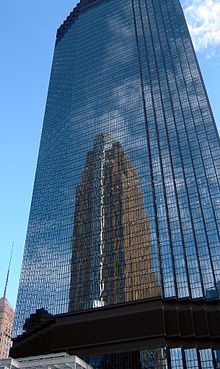 The IDS Tower, designed by Philip Johnson is the state's tallest building,[58] reflecting César Pelli's Art Deco-style Wells Fargo Center
The IDS Tower, designed by Philip Johnson is the state's tallest building,[58] reflecting César Pelli's Art Deco-style Wells Fargo Center
Minnesota's earliest industries were fur trading and agriculture; the city of Minneapolis grew around the flour mills powered by St. Anthony Falls. Although less than 1% of the population is employed in the agricultural sector,[59] it remains a major part of the state's economy, ranking 6th in the nation in the value of products sold.[60] The state is the U.S.'s largest producer of sugar beets, sweet corn, and green peas for processing, and farm-raised turkeys.[61] Forestry remains strong, including logging, pulpwood processing and paper production, and forest products manufacturing. Minnesota was famous for its soft-ore mines, which produced a significant portion of the world's iron ore for over a century. Although the high-grade ore is now depleted, taconite mining continues, using processes developed locally to save the industry. In 2004, the state produced 75% of the country's usable iron ore.[61] The mining boom created the port of Duluth which continues to be important for shipping ore, coal, and agricultural products. The manufacturing sector now includes technology and biomedical firms in addition to the older food processors and heavy industry. The nation's first indoor shopping mall was Edina's Southdale Center and its largest is Bloomington's Mall of America.
Minnesota is one of 42 U.S. states with its own lottery; its games include Powerball, Hot Lotto (both multi-state), and Gopher 5.
Energy use and production
The state produces ethanol fuel and is the first to mandate its use, a 10% mix (E10),[62] and a 20% mix (E20) in 2013.[63] There are more than 310 service stations supplying E85 fuel.[64] A 2% biodiesel blend has been required in diesel fuel since 2005. As of December 2006 the state was the country's fourth-largest producer of wind power, with 895 megawatts installed and another 200 megawatts planned, much of it on the windy Buffalo Ridge in the southwest part of the state.[65]
State taxes
Minnesota has a progressive income tax structure; the three brackets of state income tax rates are 5.35%, 7.05% and 7.85%.[66] As of 2008, Minnesota was ranked as 12th in the nation for per capita total state and local taxes.[67] In 2008, Minnesotans paid 10.2% of their income in state and local taxes, compared to the US average of 9.7% of income.[67] This ranks Minnesota 12th among the states for total state and local tax burden.[67] The state sales tax in Minnesota is 6.875%, but there is no sales tax on clothing, prescription drug medications, some services, or food items for home consumption.[68] The state legislature may allow municipalities to institute local sales taxes and special local taxes, such as the 0.5% supplemental sales tax in Minneapolis.[69] Excise taxes are levied on alcohol, tobacco, and motor fuel. The state imposes a use tax on items purchased elsewhere but used within Minnesota.[68] Owners of real property in Minnesota pay property tax to their county, municipality, school district, and special taxing districts.
Culture
Fine and performing arts
Minnesota's major fine art museums include the Minneapolis Institute of Arts, the Walker Art Center, and the Frederick R. Weisman Art Museum. The Minnesota Orchestra and the Saint Paul Chamber Orchestra are prominent full-time professional musical ensembles that perform concerts and offer educational programs to the community. Attendance at theatrical, musical, and comedy events in the area is strong. The Guthrie Theater moved into a new building in 2006, boasting three stages and overlooking the Mississippi River. In the United States, the Twin Cities' number of theater seats per capita ranks behind only New York City;[70] with some 2.3 million theater tickets sold annually.[71] The Minnesota Fringe Festival is an annual celebration of theatre, dance, improvisation, puppetry, kids' shows, visual art, and musicals. The summer festival consists of over 800 performances over 11 days in Minneapolis, and is the largest non-juried performing arts festival in the United States.[72]
Literature
The rigors and rewards of pioneer life on the prairie were the subject of Giants in the Earth by Ole Rolvaag and of the Little House series of children's books by Laura Ingalls Wilder. Small-town life was attacked by Sinclair Lewis in the novel Main Street, and more gently and affectionately satirized by Garrison Keillor in his tales of Lake Wobegon. St. Paul native F. Scott Fitzgerald wrote of the social insecurities and aspirations of the young city in stories such as Winter Dreams and The Ice Palace (published in Flappers and Philosophers). Henry Wadsworth Longfellow's epic poem The Song of Hiawatha was inspired by Minnesota and names many of the state's places and bodies of water.
Entertainment
Minnesotan musicians of many genres include rock star Prince, harmony singers The Andrews Sisters, rockabilly star Eddie Cochran, folk musician Bob Dylan, surf band The Trashmen, garage rock band The Castaways, pop songwriters Jimmy Jam & Terry Lewis, indie rock artists Jonny Lang and Soul Asylum, independent hip-hop labels Rhymesayers Entertainment and Doomtree and cult favorites such as Hüsker Dü and The Replacements.
Minnesotans have made significant contributions to comedy, theater, and film. Ole and Lena jokes are best appreciated when delivered in the accent of Scandinavian Americans. Garrison Keillor is known around the country for resurrecting old-style radio comedy with A Prairie Home Companion, which has aired since the 1970s.[12] Local television had the satirical show The Bedtime Nooz in the 1960s, while area natives Lizz Winstead and Craig Kilborn helped create the increasingly influential Daily Show decades later. Actors from the state include Eddie Albert, Judy Garland, Jessica Lange, Seann William Scott, Josh Hartnett, Jessica Biel, Vince Vaughn, Rachel Leigh Cook, Steve Zahn, Kevin Sorbo, and Winona Ryder. Joel and Ethan Coen, Terry Gilliam and Mike Todd contributed to the art of film, and others brought the offbeat cult shows Mystery Science Theater 3000 and Let's Bowl to national cable from the Twin Cities.
Popular culture
See also: List of television shows and movies in MinnesotaStereotypical Minnesotan traits include manners known as "Minnesota nice", Lutheranism, a strong sense of community and shared culture, and their distinctive brand of North Central American English sprinkled with Scandinavian-sounding words such as uff da. Potlucks, usually with a variety of hotdish casseroles, are popular at community functions, especially church activities. Minnesota's Scandinavian heritage makes lutefisk a traditional holiday dish. Movies like Fargo, Juno, A Serious Man, Drop Dead Gorgeous, New in Town, Jingle All the Way, Grumpy Old Men and Grumpier Old Men; the television series Mystery Science Theater 3000, The Golden Girls, the Mary Tyler Moore Show and Coach; the radio show A Prairie Home Companion; and the book How to Talk Minnesotan lampoon (and celebrate) Minnesotan culture, speech and mannerisms.
The Minnesota State Fair, advertised as The Great Minnesota Get-Together, is an icon of state culture. In a state of 5.2 million people, there were almost 1.8 million visitors to the fair in 2009, breaking the previous record set in 2001.[73] The fair covers the variety of life in Minnesota, including fine art, science, agriculture, food preparation, 4H displays, music, the midway, and corporate merchandising. It is known for its displays of seed art, butter sculptures of dairy princesses, the birthing barn, and the "fattest pig" competition. One can also find dozens of varieties of food on a stick, such as Pronto Pups, cheese curds, and deep fried candy bars. On a smaller scale, many of these attractions are offered at numerous county fairs.
Other large annual festivals include the Saint Paul Winter Carnival, Minnesota Renaissance Festival, Minneapolis' Aquatennial and Mill City Music Festival, Moondance Jam in Walker, Sonshine Christian music festival in Willmar, the Judy Garland Festival in Grand Rapids, Eelpout Festival on Leech Lake, and WE Fest in Detroit Lakes.
Health
The people of Minnesota have a high rate of participation in outdoor activities; the state is ranked first in the percentage of residents who engage in regular exercise.[74]
Minnesotans have low rates of premature death, infant mortality, cardiovascular disease, and occupational fatalities,[75][76] long life expectancies,[77] and a high rate of health insurance.[75][78] These and other measures have led two groups to rank Minnesota as the healthiest state in the nation, but in one of these rankings Minnesota descended from first to sixth in the nation between 2005 and 2009, due to low levels of public health funding and prevalence of binge drinking.[75][79]
On October 1, 2007 Minnesota became the seventeenth state to enact a statewide smoking ban in restaurants and bars with the enactment of Freedom to Breathe Act.[80]
Medical care is provided by a comprehensive network of hospitals and clinics, headed by two institutions with international reputations. The University of Minnesota Medical School is a highly rated teaching institution that has made a number of breakthroughs in treatment, and its research activities contribute significantly to the state's growing biotechnology industry.[81] The Mayo Clinic, a world-renowned medical practice, is based in Rochester. Mayo and the University are partners in the Minnesota Partnership for Biotechnology and Medical Genomics, a state-funded program that conducts research into cancer, Alzheimer's disease, heart health, obesity, and other areas.[82]
Education
See also: List of colleges and universities in Minnesota, List of high schools in Minnesota, and List of school districts in Minnesota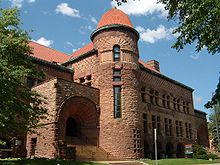 The Richardsonian Romanesque Pillsbury Hall (1889) is one of the oldest buildings on the University of Minnesota Minneapolis campus.
The Richardsonian Romanesque Pillsbury Hall (1889) is one of the oldest buildings on the University of Minnesota Minneapolis campus.
One of the first acts of the Minnesota Legislature when it opened in 1858 was the creation of a normal school at Winona. This commitment to education has contributed to a literate and well-educated population;[83] the state ranked 13th on the 2006–2007 Morgan Quitno Smartest State Award, and is first in the percentage of residents with at least a high school diploma.[84][85] But while more than 90% of high school seniors graduated in 2006, about 6% of white, 28% of African American, 30% of Asian American and more than 34% of Hispanic and Native American students dropped out of school.[86] In 2007 Minnesota students earned the highest average score in the nation on the ACT exam.[87] While Minnesota has chosen not to implement school vouchers,[88] it is home to the first charter school.[89]
The state supports a network of public universities and colleges, including 32 institutions in the Minnesota State Colleges and Universities System, and five major campuses of the University of Minnesota. It is also home to more than 20 private colleges and universities, six of which rank among the nation's top 100 liberal arts colleges, according to U.S. News and World Report.[90]
Transportation
Transportation in Minnesota is overseen by the Minnesota Department of Transportation (MnDOT for short and used in the local news media). Principal transportation corridors radiate from the Minneapolis-St. Paul metropolitan area and Duluth. The major Interstate highways are I-35, I-90, and I-94, with I-35 and I-94 passing through the Minneapolis-St. Paul metropolitan area, and I-90 going east-west along the southern edge of the state.[91] In 2006, a constitutional amendment was passed that required sales and use taxes on motor vehicles to fund transportation, with at least 40% dedicated to public transit.[92] There are nearly two dozen rail corridors in Minnesota, most of which go through Minneapolis-St. Paul or Duluth.[93] There is water transportation along the Mississippi River system and from the ports of Lake Superior.[94]
Minnesota's principal airport is Minneapolis-St. Paul International Airport (MSP), a major passenger and freight hub for Delta Air Lines and Sun Country Airlines. Most other domestic carriers serve the airport. Large commercial jet service is provided at Duluth and Rochester, with scheduled commuter service to six smaller cities via Delta Connection Contracted Carriers Comair Airlines, Mesaba Airlines, SkyWest Airlines, Compass Airlines' and Pinnacle Airlines.[95][96]
Amtrak's daily Empire Builder (Chicago–Seattle/Portland) train runs through Minnesota, calling at Midway Station in St. Paul and five other stations.[97] Intercity bus providers include Jefferson Lines, Greyhound, and Megabus. Local public transit is provided by bus networks in the larger cities and by two rail lines: The Northstar Line commuter rail service runs from Big Lake to downtown Minneapolis, and the Blue Line electrified light rail service runs from the Northstar's terminus to the MSP Airport and Bloomington.
Law and government
As with the federal government of the United States, power in Minnesota is divided into three branches: executive, legislative, and judicial.[98]
Executive
The executive branch is headed by the governor. Governor Mark Dayton, a Democrat, took office on January 3, 2011, to become the first Democratic Governor to hold the seat in two decades. The governor has a cabinet consisting of the leaders of various state government agencies, called commissioners. The other elected constitutional offices are secretary of state, attorney general, and state auditor.
Legislature
The Minnesota Legislature is a bicameral body consisting of the Senate and the House of Representatives. The state has sixty-seven districts, each covering about sixty thousand people. Each district has one senator and two representatives (each district being divided into A and B sections). Senators serve for four years and representatives for two years. In the November 2010 election, the Minnesota Republican Party gained twenty-five house seats, giving them control of the House of Representatives by a 72-62 margin.[99] The 2010 election also saw Minnesota voters elect a Republican majority in the Senate for the first time since 1972.
Judiciary
Minnesota's court system has three levels. Most cases start in the district courts, which are courts of general jurisdiction. There are 272 district court judges in ten judicial districts. Appeals from the trial courts and challenges to certain governmental decisions are heard by the Minnesota Court of Appeals, consisting of nineteen judges who typically sit in three-judge panels. The seven-justice Minnesota Supreme Court hears all appeals from the Tax Court, the Worker's Compensation Court of Appeals, first-degree murder convictions, and discretionary appeals from the Court of Appeals; it also has original jurisdiction over election disputes.[100]
Two specialized courts within administrative agencies have been established: the Workers' Compensation Court of Appeals, and the Tax Court, which deals with non-criminal tax cases.
Regional
In addition to the city and county levels of government found in the United States, Minnesota has other entities that provide governmental oversight and planning. Some actions in the Twin Cities metropolitan area are coordinated by the Metropolitan Council, and many lakes and rivers are overseen by watershed districts and soil and water conservation districts.
There are seven Anishinaabe reservations and four Dakota communities in Minnesota. These communities are self-governing.[101]
Federal
Minnesota's United States senators are Democrat Amy Klobuchar and Democrat Al Franken. The outcome of the 2008 U.S. Senate election in Minnesota was contested until June 30 the next year; when the Minnesota Supreme Court ruled in favor of Franken, Republican Norm Coleman conceded defeat, and the vacant seat was filled.[102] The state has eight congressional districts; they are represented by Tim Walz (1st district; DFL), John Kline (2nd; R), Erik Paulsen (3rd; R), Betty McCollum (4th; DFL), Keith Ellison (5th; DFL), Michele Bachmann (6th; R), Collin Peterson (7th; DFL), and Chip Cravaack (8th; R).
Federal court cases are heard in the United States District Court for the District of Minnesota, which holds court in Minneapolis, St. Paul, Duluth, and Fergus Falls. Appeals are heard by the Eighth Circuit Court of Appeals, which is based in St. Louis, Missouri and routinely also hears cases in St. Paul.
Politics
See also: List of political parties in Minnesota, United States Congressional Delegations from Minnesota, Minnesota Congressional Districts, and Political party strength in MinnesotaElection results from statewide races[103] Year Office GOP DFL Others 2008 President 43.8% 54.1% 2.1% Senator 42.0% 42.0% 16.0% 2006 Governor 46.7% 45.7% 7.6% Senator 37.9% 58.1% 4.0% 2004 President 47.6% 51.1% 1.3% 2002 Governor 44.4% 33.5% 22.1% Senator 49.5% 47.3% 1.0% 2000 President 45.5% 47.9% 6.6% Senator 43.3% 48.8% 7.9% 1998 Governor 34.3% 28.1% 37.6% 1996 President 35.0% 51.1% 13.9% Senator 41.3% 50.3% 8.4% 1994 Governor 63.3% 34.1% 2.6% Senator 49.1% 44.1% 6.8% 1992 President 31.9% 43.5% 24.6% Minnesota is known for a politically active citizenry, and populism has been a longstanding force among the state's political parties.[104][105] Minnesota has a consistently high voter turnout, due in part to its liberal voter registration laws, with virtually no evidence of voter fraud.[106] In the 2008 U.S. presidential election, 77.9% of eligible Minnesotans voted—the highest percentage of any U.S. state—versus the national average of 61.2%.[107] Previously unregistered voters can register on election day at their polls with evidence of residency.
Hubert Humphrey brought national attention to the state with his address at the 1948 Democratic National Convention. Eugene McCarthy's anti-war stance and popularity in the 1968 New Hampshire primary likely convinced Lyndon B. Johnson to drop out of the presidential election. Minnesotans have consistently cast their Electoral College votes for Democratic presidential candidates since 1976, longer than any other state. Minnesota is the only state in the nation that did not vote for Ronald Reagan in either of his presidential runs. Minnesota has gone to the Democratic Party in every Presidential Election since 1960, with the exception of 1972, when it was carried by Richard Nixon and the Republican Party.
Both the Democratic and Republican parties have major party status in Minnesota, but its state-level "Democratic" party is actually a separate party, officially known as the Minnesota Democratic-Farmer-Labor Party (DFL). Formed out of a 1944 alliance of the Minnesota Democratic and Farmer-Labor parties, the DFL now serves as a de-facto proxy to the federal Democratic Party, and its distinction from the Democratic Party, while still official, is now a functional technicality.
The state has had active third party movements. The Reform Party, now the Independence Party, was able to elect former mayor of Brooklyn Park and professional wrestler Jesse Ventura to the governorship in 1998. The Independence Party has received enough support to keep major party status. The Green Party, while no longer having major party status, has a large presence in municipal government,[108] notably in Minneapolis and Duluth, where it competes directly with the DFL party for local offices. Official "Major party" status in Minnesota (which grants state funding for elections) is reserved to parties whose candidates receive 5% or more of the vote in any statewide election (e.g., Governor, Secretary of State, U.S. President).
The state's U.S. Senate seats have generally been split since the early 1990s, and in the 108th and 109th Congresses, Minnesota's congressional delegation was split, with four representatives and one senator from each party. In the 2006 midterm election, Democrats were elected to all state offices except for governor and lieutenant governor, where Republicans Tim Pawlenty and Carol Molnau narrowly won re-election. The DFL also posted double-digit gains in both houses of the legislature, elected Amy Klobuchar to the U.S. Senate, and increased the party's U.S. House caucus by one. Keith Ellison (DFL) was elected as the first African American U.S. Representative from Minnesota as well as the first Muslim elected to Congress nationwide.[109] In 2008 DFLer and former comedian and radio talk show host Al Franken beat incumbent Republican Norm Coleman in the United States Senate race by only a few hundred votes out of 3 million cast.
In the election of 2010, Republicans took control of both chambers of the Minnesota legislature for the first time in 38 years, and Democratic-Farmer-Labor party took the governor's office for the first time in 20 years.
Media
The Twin Cities area is the fifteenth largest media market in the United States as ranked by Nielsen Media Research. The state's other top markets are Fargo-Moorhead (118th nationally), Duluth-Superior (137th), Rochester-Mason City-Austin (152nd), and Mankato (200th).[110]
Broadcast television in Minnesota and the Upper Midwest started on April 27, 1948, when KSTP-TV began broadcasting.[111] Hubbard Broadcasting, which owns KSTP, is now the only locally owned television company in Minnesota. There are currently 39 analog broadcast stations and 23 digital channels broadcast over Minnesota.
The four largest daily newspapers are the Star Tribune in Minneapolis, the Pioneer Press in Saint Paul, the Duluth News Tribune in Duluth and The Minnesota Daily, the largest student-run newspaper in the U.S.[112] Sites offering daily news on the Web include The UpTake, MinnPost, the Twin Cities Daily Planet, business news site Finance and Commerce (web site) and Washington D.C.-based Minnesota Independent. Weeklies including City Pages and monthly publications such as Minnesota Monthly are available.
Two of the largest public radio networks, Minnesota Public Radio (MPR) and Public Radio International (PRI), are based in the state. MPR has the largest audience of any regional public radio network in the nation, broadcasting on 37 radio stations.[113] PRI weekly provides more than 400 hours of programming to almost 800 affiliates.[114] The state's oldest radio station, KUOM-AM, was launched in 1922 and is among the 10 oldest radio stations in the United States. The University of Minnesota-owned station is still on the air, and since 1993 broadcasts a college rock format.
Sports and recreation
Organized sports
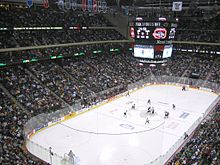 A faceoff between the University of North Dakota Fighting Sioux and the Saint Cloud State University Huskies during the WCHA Final Five at the Xcel Energy Center.
A faceoff between the University of North Dakota Fighting Sioux and the Saint Cloud State University Huskies during the WCHA Final Five at the Xcel Energy Center.
Minnesota has professional men's teams in all major sports. The Hubert H. Humphrey Metrodome is home to the Minnesota Vikings of the National Football League. The building formerly hosted The Minnesota Twins of Major League Baseball, winners of the 1987 and 1991 World Series. The Twins began playing in the new outdoor Target Field in 2010. The Minnesota Timberwolves of the National Basketball Association play in the Target Center. The National Hockey League's Minnesota Wild team reached 300 consecutive sold-out games in St. Paul's Xcel Energy Center on January 16, 2008.[115] The NSC Minnesota Stars replaced the United Soccer League Minnesota Thunder in 2010 and plays at the National Sports Center in Blaine.[116]
Minor league baseball is represented both by major league-sponsored teams and independent teams such as the popular St. Paul Saints.
Professional women's sports include the Minnesota Lynx of the [[Women's National Basketball Association]who just won the WNBA championship in 2011], the Minnesota Lightning of the United Soccer Leagues W-League, the Minnesota Vixen of the Independent Women's Football League, and the Minnesota Whitecaps of the National Women's Hockey League.
The Twin Cities campus of the University of Minnesota is a National Collegiate Athletic Association (NCAA) Division I school, with the university's sports teams competing in either the Big Ten Conference or the Western Collegiate Hockey Association. Four additional schools in the state compete in NCAA Division I ice hockey: the University of Minnesota Duluth, Minnesota State University, Mankato, St. Cloud State University, and Bemidji State University. There are nine NCAA Division II colleges in the Northern Sun Intercollegiate Conference, and nineteen NCAA Division III colleges in the Minnesota Intercollegiate Athletic Conference and Upper Midwest Athletic Conference.[117][118]
Winter Olympic Games medallists from the state include twelve of the twenty members of the gold medal 1980 ice hockey team (coached by Minnesota native Herb Brooks) and the bronze medallist U.S. men's curling team in the 2006 Winter Olympics. Swimmer Tom Malchow won an Olympic gold medal in the 2000 Summer games and a silver medal in 1996.
Grandma's Marathon is run every summer along the scenic North Shore of Lake Superior, and the Twin Cities Marathon winds around lakes and the Mississippi River during the peak of the fall color season.
Outdoor recreation
Minnesotans participate in high levels of physical activity,[119] and many of these activities are outdoors. The strong interest of Minnesotans in environmentalism has been attributed to the popularity of these pursuits.[120]
In the warmer months, these activities often involve water. Weekend and longer trips to family cabins on Minnesota's numerous lakes are a way of life for many residents. Activities include water sports such as water skiing, which originated in the state,[121] boating, canoeing, and fishing. More than 36% of Minnesotans fish, second only to Alaska.[122]
Fishing does not cease when the lakes freeze; ice fishing has been around since the arrival of early Scandinavian immigrants.[123] Minnesotans have learned to embrace their long, harsh winters in ice sports such as skating, hockey, curling, and broomball, and snow sports such as cross-country skiing, alpine skiing, snowshoeing, and snowmobiling.[124]
State and national forests and the seventy-two state parks are used year-round for hunting, camping, and hiking. There are almost 20,000 miles (32,000 km) of snowmobile trails statewide.[125] Minnesota has more miles of bike trails than any other state,[126] and a growing network of hiking trails, including the 235-mile (378 km) Superior Hiking Trail in the northeast.[127] Many hiking and bike trails are used for cross-country skiing during the winter.
State symbols
Main article: Lists of U.S. state insignia The Common Loon's distinctive cry is heard during the summer months on lakes throughout the state.[128]
The Common Loon's distinctive cry is heard during the summer months on lakes throughout the state.[128]
Minnesota's state symbols:[129]
- State bird: Common Loon
- State butterfly: Monarch
- State drink: Milk
- State fish: Walleye
- State flower: Pink and white lady slipper
- State fruit: Honeycrisp apple
- State gemstone: Lake Superior agate
- State grain: Wild rice
- State motto: L'Étoile du Nord ("The Star of the North")
- State muffin: Blueberry
- State mushroom: Morel
- State photograph: Grace
- State song: "Hail! Minnesota"
- State sport: Ice hockey
- State tree: Red Pine also known as Norway Pine
- Nicknames:
- "Land of 10,000 Lakes"
- "North Star State"
- "Gopher State"
- "Land of Sky-Blue Waters"
- "Bread and Butter State" (A reference to the grain and dairy products Minnesota produces)
See also
- Outline of Minnesota
- Index of Minnesota-related articles
References
- ^ "Annual Estimates of the Resident Population for the United States, Regions, States, and Puerto Rico: April 1, 2000 to July 1, 2009". United States Census Bureau. http://www.census.gov/popest/states/NST-ann-est.html. Retrieved 2009-12-23.
- ^ Median Household Income, from U.S. Census Bureau (from 2007 American Community Survey, U.S. Census Bureau. Retrieved 2009-04-09.
- ^ a b c "Elevations and Distances in the United States". United States Geological Survey. 2001. http://egsc.usgs.gov/isb/pubs/booklets/elvadist/elvadist.html. Retrieved October 24, 2011.
- ^ a b Elevation adjusted to North American Vertical Datum of 1988.
- ^ a b Minnesota. Dictionary.com. The American Heritage Dictionary of the English Language, Fourth Edition. Houghton Mifflin Company, 2004. Retrieved on 2008-04-26.
- ^ a b "Minnesota State". Minnesota Historical Society. http://mnplaces.mnhs.org/upham/otheritem.cfm?PlaceNameID=2007&BookCodeID=67&County=0&SendingPage=Results.cfm. Retrieved 2008-04-26.
- ^ "Minnehaha Creek". Minnesota Historical Society. http://mnplaces.mnhs.org/upham/Waterway.cfm?PlaceNameID=2002&BookCodeID=9&County=27&SendingPage=Results.cfm. Retrieved 2008-04-26.
- ^ "Just the Facts". Minnesota North Star (official state government site).. http://www.state.mn.us/portal/mn/jsp/content.do?id=-8542&subchannel=null&sc2=null&sc3=null&contentid=536879492&contenttype=EDITORIAL&programid=536888179&agency=NorthStar. Retrieved on 2009-07-04.
- ^ "Facts and figures". infoplease.com. 2007. http://www.infoplease.com/ce6/us/A0859662.html. Retrieved 2008-04-09.
- ^ "Land and Water Area of States, 2000". Information Please. 2007. http://www.infoplease.com/ipa/A0108355.html. Retrieved 2008-04-09.
- ^ a b c d e f g h i Ojakangas, Richard W.; Charles L. Matsch (1982). Minnesota's Geology. Illus. Dan Breedy. Minneapolis, Minnesota: University of Minnesota Press. ISBN 0-8166-0953-5.
- ^ a b c d Breining, Greg (December 2005). Compass American Guides: Minnesota, 3rd Edition (3rd ed.). Compass American Guides. ISBN 1-4000-1484-0.
- ^ "Natural history - Minnesota's geology". Minnesota DNR. 2008. http://www.dnr.state.mn.us/snas/naturalhistory.html. Retrieved 2008-04-09.
- ^ "Table Showing Minnesota Earthquakes". University of Minnesota, Morris. http://www.mrs.umn.edu/earthquakes/MNeqchart.html. Retrieved 2008-04-09.
- ^ "118 km (73 mi) SW of Thunder Bay, Ontario, Canada". Topographic map. U.S.G.S via terraserver.microsoft.com. 1964-07-01. http://msrmaps.com/map.aspx?t=2&s=16&lon=-90.56700164&lat=47.79184974&w=600&h=400&opt=0. Retrieved 2010-04-13.
- ^ "Continental Divides in North Dakota and North America". National Atlas. 2007-10-02. http://nationalatlas.gov/articles/geology/a_continentalDiv.html. Retrieved 2008-04-09.
- ^ a b c d "Lakes, rivers & wetlands". MN Facts. Minnesota DNR. 2008. http://www.dnr.state.mn.us/faq/mnfacts/water.html. Retrieved 2008-04-09.
- ^ Seeley, Mark (2006). Minnesota Weather Almanac. Minnesota Historical Society press. ISBN 0-87351-554-4.
- ^ Ecological Provinces, Ecological Classification System, Minnesota Department of Natural Resources (1999). Retrieved on 2008-05-03.
- ^ Heinselman, Miron (1996). The Boundary Waters Wilderness Ecosystem. Minneapolis, Minnesota: University of Minnesota Press. ISBN 0-8166-2805-X.
- ^ Bewer, Tim (2004). Moon Handbooks Minnesota (First ed.). Avalon Travel Publishing. ISBN 1-56691-482-5.
- ^ "Upper Midwest forest-savanna transition (NA0415)". Terrestrial Ecoregions. World Wildlife Fund. 2001. http://www.worldwildlife.org/wildworld/profiles/terrestrial/na/na0415_full.html. Retrieved 2008-04-14.
- ^ Bison disappeared in the mid 19th century; the last bison was reported in southwest Minnesota in 1879. Moyle, J. B. (1965). Big Game in Minnesota, Technical Bulletin, no. 9. Minnesota Department of Conservation, Division of Game and Fish, Section of Research and Planning. p. 172. As referenced in Anfinson, Scott F. (1997). Southwestern Minnesota Archaeology. St. Paul, Minnesota: Minnesota Historical Society. p. 20. ISBN 0-87351-355-X.
- ^ Gray Wolf Factsheet, U.S. Fish and Wildlife Service (January 2007). Retrieved on 2008-05-03.
- ^ "Minnesota climate extremes". University of Minnesota. http://climate.umn.edu/doc/historical/extremes.htm. Retrieved 2008-05-03.
- ^ a b c "Climate of Minnesota" (PDF). National Weather Service Forecast Office. Archived from the original on May 28, 2008. http://web.archive.org/web/20080528042433/http://www5.ncdc.noaa.gov/climatenormals/clim60/states/Clim_MN_01.pdf. Retrieved 2008-05-03.
- ^ "104 Years of Twin Cities Dew Point Temperature Records: 1902–2006". Minnesota Climatology Office. March 7, 2006. http://climate.umn.edu/doc/twin_cities/mspdewpoint.htm. Retrieved 2008-04-06.
- ^ "Itasca State Park". Minnesota Department of Natural Resources. http://www.dnr.state.mn.us/state_parks/itasca/narrative.html. Retrieved 2008-05-03.
- ^ "Places To Go". National Park Service, U.S. Department of the Interior. http://www.nps.gov/miss/planyourvisit/placestogo.htm. Retrieved 2008-05-03.
- ^ "TimePieces". Minnesota Historical Society. http://events.mnhs.org/TimePieces/timeline.cfm. Retrieved 2006-09-19.
- ^ a b c d Lass, William E. (1998) [1977]. Minnesota: A History (2nd ed.). New York, NY: W.W. Norton & Company. ISBN 0-393-04628-1.
- ^ a b c d e Gilman, Rhoda R. (1991-07-01). The Story of Minnesota's Past. St. Paul, Minnesota: Minnesota Historical Society Press. ISBN 0-87351-267-7.
- ^ "Historic Fort Snelling". Minnesota Historical Society Press. http://www.mnhs.org/places/sites/hfs/history.html. Retrieved 2006-07-06.
- ^ Kunnen-Jones, Marianne (2002-08-21). "Anniversary Volume Gives New Voice To Pioneer Accounts of Sioux Uprising". University of Cincinnati. http://www.uc.edu/news/sioux.htm. Retrieved 2007-06-06.
- ^ Steil, Mark and Tim Post. Hundreds of settlers killed in attacks. Minnesota Public Radio. September 26, 2002.
- ^ Hazen, Theodore R.. "New Process Milling of 1850–70". Pond Lily Mill Restorations. http://www.angelfire.com/journal/millrestoration/newprocess.html. Retrieved 2007-05-11.
- ^ Danbom, David B. (Spring 2003). "Flour Power: The Significance of Flour Milling at the Falls". Minnesota History 58 (5): 271–285.
- ^ "Engineering Research Associates Records 1946–1959". Hagley Museum and Library. http://www.hagley.lib.de.us/2015.htm. Retrieved 2006-11-26.
- ^ "Population in Metropolitan Statistical Areas Ranked by 2000 Census" (PDF). U.S. Census Bureau. http://www.census.gov/population/cen2000/phc-t29/tab03a.pdf. Retrieved 2008-04-07.
- ^ a b "Population Estimates". Minnesota Demographic Center. http://www.demography.state.mn.us/estimates.html. Retrieved 2008-04-07.
- ^ a b "Environmental Information Report, App. D Socioeconomic Information" (PDF). Minnesota Pollution Control Agency. 2003-05-30. http://www.pca.state.mn.us/publications/reports/eir-appendix-e.pdf. Retrieved 2008-04-07.
- ^ "Table 1: Annual Estimates of the Population for the United States, Regions, States, and Puerto Rico: April 1, 2000 to July 1, 2007 (NST-EST2007-01)". Population Division, U.S. Census Bureau. December 27, 2007. http://quickfacts.census.gov/qfd/states/27000.html. Retrieved 2008-02-12.
- ^ "Minnesota QuickFacts from the US Census Bureau". http://quickfacts.census.gov/qfd/states/27000.html. Retrieved 2006-11-26.
- ^ "statecenters". U.S. Census Bureau. 2000. http://www.census.gov/geo/www/cenpop/statecenters.txt. Retrieved 2006-11-21.
- ^ Minnesota Selected Social Characteristics in the United States, 2008 American Community Survey 1–year Estimates, U.S. Census Bureau, 2008. Retrieved 2010-03-19.
- ^ Selected Social Characteristics in the United States: 2005-2007, Minnesota, U.S. Census Bureau. Retrieved on 2009-07-04.
- ^ Fact Sheet, 2010 American Census Bureau Estimates, Retrieved on 2010-03-18.
- ^ "Religious Composition of Minnesota". Maps, U.S. Religious Landscape Survey. Pew Research Center. 2010. http://religions.pewforum.org/maps. Retrieved 2010-03-19.
- ^ "American Religious Identification Survey". Exhibit 15. The Graduate Center, City University of New York. http://www.gc.cuny.edu/faculty/research_briefs/aris/key_findings.htm. Retrieved 2006-11-24.
- ^ "Environmental Information Report, App. D Socioeconomic Information" (PDF). 2003-05-30. http://www.pca.state.mn.us/publications/reports/eir-appendix-e.pdf. Retrieved 2006-11-19.
- ^ "Gross Domestic Product (GDP) by State". U.S. Bureau of Economic Analysis. 2006-10-26. http://www.bea.gov/regional/gsp/. Retrieved 2006-11-13.
- ^ "FORTUNE 500 2006: States". CNN Money. http://money.cnn.com/magazines/fortune/fortune500/2008/states/MN.html. Retrieved 2009-03-25.
- ^ Forbes (2008). "Largest US Private Cos. 2008". http://www.forbes.com/lists/2008/21/privates08_Cargill_5ZUZ.html. Retrieved 2009-01-25.
- ^ "Our Brands". Carlson Companies. Archived from the original on October 24, 2007. http://web.archive.org/web/20071024112507/http://carlson.com/brands/index.cfm. Retrieved 2010-01-05.
- ^ "State Personal Income 2008". U.S. Bureau of Economic Analysis. http://www.bea.gov/newsreleases/regional/spi/2009/pdf/spi0309.pdf. Retrieved 2009-07-04.
- ^ "United States and States - R2001. Median Household Income". U.S. Census Bureau. Archived from the original on July 5, 2007. http://web.archive.org/web/20070705202154/http://www.census.gov/hhes/www/income/income04/statemhi.html. Retrieved 2007-08-05.
- ^ Bls.gov; Local Area Unemployment Statistics
- ^ Coleman, Nick (24 March 2008). "Capella Tower sports a cap, but it can't topple the IDS". Star Tribune. http://www.startribune.com/local/16942626.html. Retrieved 19 November 2009.
- ^ "Minnesota - DP-3. Profile of Selected Economic Characteristics: 2000". U.S. Census Bureau. http://factfinder.census.gov/servlet/QTTable?_bm=y&-geo_id=04000US27&-qr_name=DEC_2000_SF3_U_DP3&-ds_name=DEC_2000_SF3_U&-_lang=en&-_sse=on. Retrieved 2006-11-26.
- ^ "Census of Agriculture, Minnesota State Profile" (PDF). U.S. Department of Agriculture. Archived from the original on October 1, 2006. http://web.archive.org/web/20061001103025/http://www.nass.usda.gov/census/census02/profiles/mn/cp99027.PDF. Retrieved 2006-12-03.
- ^ a b "Wealth of Resources". Minnesota Department of Employment and Economic Development. http://www.deed.state.mn.us/whymn/resources.htm. Retrieved 2006-11-26.
- ^ "Ethanol Producer Magazine". Ethanol Producer Magazine. http://www.ethanolproducer.com/article.jsp?article_id=1905. Retrieved 2006-11-26.
- ^ "2005 Senate Bill 4 (Ethanol Mandate Increase)". Minnesota Votes. http://www.minnesotavotes.org/2005-SF-4. Retrieved 2006-11-26.
- ^ "The complete list of Minnesota E85 fuel Sites". Minnesota Department of Commerce. Archived from the original on November 24, 2006. http://web.archive.org/web/20061124140631/http://www.state.mn.us/portal/mn/jsp/content.do?subchannel=-536881511&programid=536907776&sc3=null&sc2=-536888997&id=-536881350&agency=Commerce. Retrieved 2006-11-26.
- ^ "Wind Energy Projects Throughout the United States of America". The American Wind Energy Association. Archived from the original on 2007-04-06. http://web.archive.org/web/20070406043547/http://www.awea.org/projects. Retrieved 2007-05-07.
- ^ "Minnesota income tax rates for 2005/2006". Minnesota Department of Revenue. http://www.taxes.state.mn.us/individ/residency_and_filing_status/filing_requirments_for_individuals/inctxrates.shtml. Retrieved 2006-11-26.
- ^ a b c "Minnesota's State and Local Tax Burden 1977-2008". The Tax Foundation. http://www.taxfoundation.org/taxdata/show/462.html. Retrieved 2010-06-06.
- ^ a b "Minnesota Sales and Use Tax Instruction Book" (PDF). Minnesota Department of Revenue. July 2009. http://www.taxes.state.mn.us/taxes/sales/instructions/st_bk_rev0709.pdf. Retrieved 2010-06-06.[dead link]
- ^ "Local Sales Tax and Use" (PDF). Minnesota Department of Revenue. Archived from the original on 2006-10-09. http://web.archive.org/web/20061009052806/http://www.taxes.state.mn.us/taxes/sales/publications/fact_sheets_by_name/content/BAT_1100111.pdf. Retrieved 2006-11-26.
- ^ "Gopher Express". Coffman Info Desk. Regents of the University of Minnesota. 2006-10-12. http://www.skyway.umn.edu/gopherexpresswest/explore.php?PHPSESSID=f65d1b639e4cae622e89d4f98605c590. Retrieved 2007-05-06.
- ^ Royce, Graydon Royce (2006-04-01). "New Guthrie casts a huge shadow over theater scene". Minneapolis Star-Tribune via SavetheGuthrie.org. Archived from the original on May 18, 2006. http://web.archive.org/web/20060518153633/http://www.savetheguthrie.org/news/royce040106.htm. Retrieved 2007-05-06.
- ^ "How to fringe". Fresh Art Delivered Daily. Minnesota Fringe Festival. 2006. Archived from the original on November 14, 2006. http://web.archive.org/web/20061114023612/http://www.fringefestival.org/new.cfm. Retrieved 2006-11-22.
- ^ "Minnesota State Fair". Minnesota State Fair. http://www.mnstatefair.org/. Retrieved 2009-09-10.
- ^ "Statemaster Health Statistics Physical Exercise by State". Statemaster. 2002. http://www.statemaster.com/graph/hea_phy_exe-health-physical-exercise. Retrieved 2006-08-16.
- ^ a b c "America's Health Rankings 2009". United Health Foundation. 2009. http://www.americashealthrankings.org/yearcompare/2008/2009/MN.aspx. Retrieved 2010-04-11.
- ^ "Statemaster Health Statistics > Death Rate per 100,000". Statemaster. http://www.statemaster.com/graph/hea_dea_rat_per_100-death-rate-per-100-000. Retrieved 2006-08-16.
- ^ "Explore Minnesota Living" (PDF). Minnesota Department of Employment and Economic Development. http://www.deed.state.mn.us/publications/MNLiving.pdf. Retrieved 2006-08-16.
- ^ "The Percentage of People Without Health Insurance Coverage by State Using 2- and 3-year Averages: 2003 to 2005" (PDF). Health Insurance Coverage: 2005. U.S. Census Bureau, Housing and Household Economic Statistics Division. 2006-08-29. Archived from the original on October 6, 2006. http://web.archive.org/web/20061006081530/http://www.census.gov/hhes/www/hlthins/hlthin05/hi05t10.pdf. Retrieved 2006-11-24.
- ^ "Health Statistics Health Index by state". Statemaster. http://www.statemaster.com/graph/hea_hea_ind-health-index. Retrieved 2006-08-16.
- ^ "Put 'Em Out: Minnesota Smoking Ban Kicks In Monday". WCCO. September 29, 2007. Archived from the original on December 27, 2007. http://web.archive.org/web/20071227004710/http://wcco.com/health/local_story_272145441.html. Retrieved 2007-10-01.
- ^ "University of Minnesota Medical Milestones". University of Minnesota Medical School. 2002. http://www.med.umn.edu/faculty/handbook/info/home.html. Retrieved 2006-08-14.
- ^ "Minnesota Partnership for Biotechnology and Medical Genomics". University of Minnesota Medical School. 2002. http://www.minnesotapartnership.info/. Retrieved 2006-08-14.
- ^ Table 228: Educational Attainment by State, U.S. Bureau of the Census, showing Minnesota with a 91% high school graduation rate in 2006, second-highest in the nation. Retrieved 1020-10-12.
- ^ "Smartest State Award". Morgan Quitno Press. http://www.morganquitno.com/edrank.htm. Retrieved 2006-07-24.
- ^ "High school diploma or higher, by percentage by state". Statemaster.com. 2004. http://www.statemaster.com/graph/edu_hig_sch_dip_or_hig_by_per-high-school-diploma-higher-percentage. Retrieved 2006-08-16.
- ^ "Status of Girls in Minnesota" (PDF). Women's Foundation of Minnesota and the Institute for Women's Policy Research. April 2008. http://www.wfmn.org/PDFs/StatusOfGirlsInMN_FullReportFINAL.pdf. Retrieved 2008-04-29.
- ^ "Minnesota's Class of 2007 leads the nation in ACT scores". Multimedia Holdings Corporation. 2007. http://www.kare11.com/news/news_article.aspx?storyid=262186. Retrieved 2007-08-15.
- ^ Hallman, Charles (2007-03-14). "School vouchers: Who stands to gain at what cost?". Minnesota Spokesman-Recorder. http://spokesman-recorder.com/news/Article/Article.asp?NewsID=76873&sID=4.
- ^ "Charter Schools". Minnesota Department of Education. 2007. http://education.state.mn.us/MDE/Academic_Excellence/School_Choice/Public_School_Choice/Charter_Schools/index.html. Retrieved 2007-05-06.
- ^ "Best Colleges 2009: Liberal Arts Rankings". USNews.com. 2009. http://colleges.usnews.rankingsandreviews.com/college/liberal-arts-search/. Retrieved 2009-03-25.
- ^ Minnesota Department of Transportation (PDF). 2007–2008 Official Highway Map (Map). http://www.dot.state.mn.us/statemap/pdf/MNmap.pdf. Retrieved 2008-04-07.
- ^ "Transportation amendment update". Minnesota Department of Transportation. 2006. Archived from the original on June 26, 2008. http://web.archive.org/web/20080626041042/http://www.dot.state.mn.us/information/mvst/index.html. Retrieved 2008-04-07.
- ^ Minnesota Department of Transportation (2007) (PDF). Minnesota Rail System (Map). http://www.dot.state.mn.us/ofrw/maps/RailLines20070806_1.pdf. Retrieved 2007-04-07.
- ^ "Minnesota Ports and Waterways". Minnesota Department of Transportation. http://www.dot.state.mn.us/ofrw/waterways.html. Retrieved 2008-04-07.
- ^ "Airports with Scheduled Air Service". Commercial Service Airports. Minnesota Department of Transportation. 2008. http://www.dot.state.mn.us/aero/avoffice/commaviation.html. Retrieved 2008-04-07.
- ^ "Route Map". Mesaba Airlines. Archived from the original on July 3, 2008. http://web.archive.org/web/20080703225636/http://www.mesaba.com/documents/Routemap.jpg. Retrieved 2008-04-07.
- ^ "Amtrak - Routes - Northwest". Amtrak. http://www.amtrak.com/servlet/ContentServer?pagename=Amtrak/am2Route/Horizontal_Route_Page&c=am2Route&cid=1081256321887&ssid=135. Retrieved 2008-04-07.
- ^ "Minnesota Government". State of Minnesota. http://www.state.mn.us/portal/mn/jsp/content.do?id=-8494&agency=NorthStar. Retrieved 2006-10-20.
- ^ 2011 House Profile Minnesota House of Representatives. Retrieved 2011-06-22.
- ^ "Minnesota Supreme Court" (doc). Court Information Office, State of Minnesota. http://www.courts.state.mn.us/documents/CIO/otherResources/SupremeCourt.doc. Retrieved 2006-10-19.
- ^ "Tribal Government". Minnesota North Star. http://www.state.mn.us/portal/mn/jsp/content.do?subchannel=-536888182&id=-8494&agency=NorthStar. Retrieved 2006-10-20.
- ^ Davey, Monica; Hulse, Carl (2009-06-30), "After 8 Months, Franken Wins Senate Seat in Minnesota", The New York Times, http://www.nytimes.com/2009/07/01/us/politics/01minnesota.html?hp, retrieved 2009-06-30
- ^ http://uselectionatlas.org/RESULTS/
- ^ Leigh Pomeroy (2007). "Populism Is Alive and Well in Southern Minnesota". Minnesota Monitor. Archived from the original on October 8, 2007. http://web.archive.org/web/20071008194926/http://www.minnesotamonitor.com/showDiary.do?diaryId=1728. Retrieved 2008-08-04.
- ^ Grayson, Katharine (2006-09-18). "Study: Minnesota tops nation in voter turnout". Minneapolis St. Paul Business Journal. http://twincities.bizjournals.com/twincities/stories/2006/09/18/daily3.html?surround=lfn. Retrieved 2008-08-04.
- ^ Huefner, Steven F., Daniel P Tokaji, and Edward B. Foley (2007), ‘'From Registration to Recounts: The Election Ecosystems of Five Midwestern States'’, The Ohio State University Moritz College of Law, p. 137. ISBN 978-0-9801400-0-2.
- ^ Michael P. McDonald. "2008 Unofficial Voter Turnout". United States Elections Project, George Mason University. http://elections.gmu.edu/preliminary_vote_2008.html. Retrieved 2008-11-20.
- ^ "Office Holders". Green Party of Minnesota. Archived from the original on January 7, 2007. http://web.archive.org/web/20070107163820/http://www.mngreens.org/officeholders.php. Retrieved 2007-04-18.
- ^ "Minnesota Democrat becomes first Muslim to win seat in Congress". Associated Press. International Herald Tribune. 2006-11-07. http://www.iht.com/articles/ap/2006/11/08/america/NA_POL_US_Election_Muslim.php. Retrieved 2006-12-11.
- ^ "210 Designated Market Areas - 03-04". Nielsen Media. Archived from the original on 2006-05-17. http://web.archive.org/web/20060517010320/http://www.nielsenmedia.com/DMAs.html. Retrieved 2006-11-26.
- ^ "5 EYEWITNESS NEWS History". kstp.com. http://www.kstp.com/article/stories/S278.shtml?cat=14. Retrieved 2007-03-28.
- ^ "Daily Board of Directors". The Minnesota Daily. Archived from the original on April 8, 2008. http://web.archive.org/web/20080408053528/http://www.mndaily.com/board.php. Retrieved 2008-04-28.
- ^ "About MPR". Minnesota Public Radio. http://minnesota.publicradio.org/about/mpr/. Retrieved 2006-08-17.
- ^ "PRI factsheet". Public Radio International. http://www.pri.org/InPRI_FactSheet.html. Retrieved 2007-05-07.
- ^ "Recap, Flames 3, Wild 2, SO". Minnesota Wild. 2008-01-17. http://wild.nhl.com/team/app/?service=page&page=Recap&gameNumber=688&season=20072008&gameType=2. Retrieved 2008-04-07.
- ^ Quarstad, Brian (2010-01-07). "National Sports Center Announces New Professional Soccer Team". Inside Minnesota Soccer. http://www.insidemnsoccer.com/2010/01/07/national-sports-center-announces-new-professional-soccer-team/. Retrieved 2010-04-29.
- ^ "NCAA Members By Division". NCAA. http://web1.ncaa.org/onlineDir/exec/divisionListing?sortOrder=4&division=All. Retrieved 2009-04-13.
- ^ "Upper Midwest Athletic Conference - History". Upper Midwest Athletic Conference. http://www.umacathletics.com/Sports/gen/2008/History.asp?nl=25&tab=abouttheumac. Retrieved 2009-04-13.
- ^ "Statemaster Health Statistics Physical Exercise by State". Statemaster. 2002. http://www.statemaster.com/graph/hea_phy_exe-health-physical-exercise. Retrieved 2008-04-07.
- ^ "Green Hunters: Minnesota DNR". Fish & Wildlife Today. Archived from the original on February 1, 2008. http://web.archive.org/web/20080201043003/http://www.dnr.state.mn.us/fwt/back_issues/september97/message.html. Retrieved 2008-04-07.
- ^ "Water Skiing History". ABC of Skiing. MaxLifestyle.net "Go Skiing like Max!". 2006. http://www.abc-of-skiing.com/water-skiing/history.asp. Retrieved 2008-04-07.
- ^ "Managing for Results" (PDF). Minnesota DNR. http://files.dnr.state.mn.us/aboutdnr/budget/budgetpres0303.pdf. Retrieved 2008-04-07.
- ^ Benjamin, Robert W. (2006-07-15). "Ice Fishing can be a very exciting experience". Buzzle.com. http://www.buzzle.com/editorials/7-15-2006-102438.asp. Retrieved 2008-04-07.
- ^ "Turning Snow into Sport". Explore Minnesota Experiences. Minnesota Department of Tourism. Archived from the original on April 1, 2008. http://web.archive.org/web/20080401034153/http://www.exploreminnesota.com/experiences/outdoors/snow/index.aspx. Retrieved 2008-04-07.
- ^ "Snowmobiling Minnesota". Minnesota Department of Tourism. Archived from the original on June 4, 2008. http://web.archive.org/web/20080604210514/http://www.exploreminnesota.com/story.aspx?EntityId=19499. Retrieved 2008-04-07.
- ^ "Take to the Trails! Explore Minnesota Biking". Minnesota Department of Tourism. Archived from the original on January 27, 2008. http://web.archive.org/web/20080127122558/http://www.exploreminnesota.com/experiences/outdoors/biking/index.aspx. Retrieved 2008-04-07.
- ^ "Superior Hiking Trail". Minnesota Department of Tourism. http://www.exploreminnesota.com/listing.aspx?EntityID=7727. Retrieved 2006-12-02.
- ^ "All About Birds". Cornell Lab of Ornithology. 2003. http://www.birds.cornell.edu/AllAboutBirds/BirdGuide/Common_Loon_dtl.html. Retrieved 2006-10-24.
- ^ "Minnesota State Symbols". Minnesota State Legislature. http://www.leg.state.mn.us/leg/Symbols.asp. Retrieved 2008-04-28.
External links
General
- Minnesota at the Open Directory Project
Government
- State of Minnesota Official site
- Minnesota State Legislature
- Minnesota Judicial Branch
- Hyperlinked state constitution
- Full text of state constitution
- Energy Data & Statistics for Minnesota- From the U.S. Department of Energy
Tourism & recreation
- Minnesota Department of Natural Resources
- Minnesota DNR Outdoor Activities
- Minnesota travel guide from Wikitravel
Culture & history
- Minnesota Aviation Hall of Fame
- Minnesota Historical Society
- Minnesota history timeline
- Minnesota Historical Society's online timeline
- A History of Minneapolis: Early History: Resources
- Minnesota Place Names
- Forests, Fields, and the Falls: Connecting Minnesota
Maps and Demographics
- Minnesota State Demographic Center
- Minnesota Health and Demographic Data
- USGS real-time, geographic, and other scientific resources of Minnesota
- Minnesota Demographics Facts
- Minnesota State Highway Map
- Perry-Castañeda Library Map Collection
- John R. Borchert Map Library
- Minnesota Geological Survey
Preceded by
CaliforniaList of U.S. states by date of statehood
Admitted on May 11, 1858 (32nd)Succeeded by
Oregon
 Canada
Canada
 Manitoba •
Manitoba •  Ontario
Ontario
 North Dakota
North Dakota
Lake Superior
 Wisconsin
Wisconsin Minnesota: Outline • Index
Minnesota: Outline • Index 

 South Dakota
South Dakota Iowa
IowaPolitical divisions of the United States States - Alabama
- Alaska
- Arizona
- Arkansas
- California
- Colorado
- Connecticut
- Delaware
- Florida
- Georgia
- Hawaii
- Idaho
- Illinois
- Indiana
- Iowa
- Kansas
- Kentucky
- Louisiana
- Maine
- Maryland
- Massachusetts
- Michigan
- Minnesota
- Mississippi
- Missouri
- Montana
- Nebraska
- Nevada
- New Hampshire
- New Jersey
- New Mexico
- New York
- North Carolina
- North Dakota
- Ohio
- Oklahoma
- Oregon
- Pennsylvania
- Rhode Island
- South Carolina
- South Dakota
- Tennessee
- Texas
- Utah
- Vermont
- Virginia
- Washington
- West Virginia
- Wisconsin
- Wyoming
Federal district Insular areas Outlying islands United States (Outline) History Pre-Columbian era · Colonial era (Thirteen Colonies · Colonial American military history) · American Revolution (War) · Federalist Era · War of 1812 · Territorial acquisitions · Territorial evolution · Mexican–American War · Civil War · Reconstruction era · Indian Wars · Gilded Age · African-American Civil Rights Movement (1896–1954) · Spanish–American War · Imperialism · World War I · Roaring Twenties · Great Depression · World War II (Home front) · Cold War · Korean War · Space Race · African-American Civil Rights Movement (1955–1968) · Feminist Movement · Vietnam War · Post-Cold War (1991–present) · War on Terror (War in Afghanistan · Iraq War) · Timeline of modern American conservatismTopicsDemographic · Discoveries · Economic (Debt Ceiling) · Inventions (before 1890 · 1890–1945 · 1946–1991 · after 1991) · Military · Postal · Technological and industrialFederal
governmentLegislature - Congress
Senate
· Vice President
· President pro tem
House of Representatives
· Speaker
Judiciary - Supreme Court
Federal courts
Courts of appeal
District courtsExecutive - President
Executive Office
Cabinet / Executive departments
Civil service
Independent agencies
Law enforcement
Public policy
Intelligence
Central Intelligence Agency
Defense Intelligence Agency
National Security Agency
Federal Bureau of InvestigationPolitics Divisions · Elections (Electoral College) · Foreign policy · Foreign relations · Ideologies · Local governments · Parties (Democratic Party · Republican Party · Third parties) · Political status of Puerto Rico · Red states and blue states · Scandals · State governments · Uncle SamGeography Cities, towns, and villages · Counties · Extreme points · Islands · Mountains (Peaks · Appalachian · Rocky) · National Park System · Regions (Great Plains · Mid-Atlantic · Midwestern · New England · Northwestern · Southern · Southwestern · Pacific · Western) · Rivers (Colorado · Columbia · Mississippi · Missouri · Ohio · Rio Grande) · States · Territory · Water supply and sanitationEconomy Agriculture · Banking · Communications · Companies · Dollar · Energy · Federal Budget · Federal Reserve System · Financial position · Insurance · Mining · Public debt · Taxation · Tourism · Trade · Transportation · Wall StreetSociety TopicsCrime · Demographics · Education · Family structure · Health care · Health insurance · Incarceration · Languages (American English · Spanish · French) · Media · People · Public holidays · Religion · SportsArchitecture · Art · Cinema · Cuisine · Dance · Fashion · Flag · Folklore · Literature · Music · Philosophy · Radio · Television · TheaterIssuesCategories:- Minnesota
- States and territories established in 1858
- States of the United States
Wikimedia Foundation. 2010.

